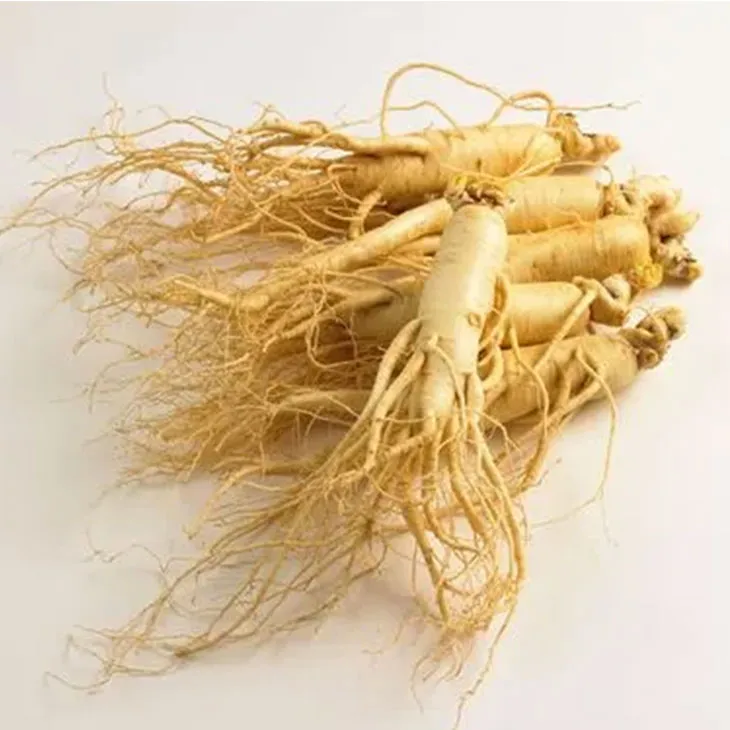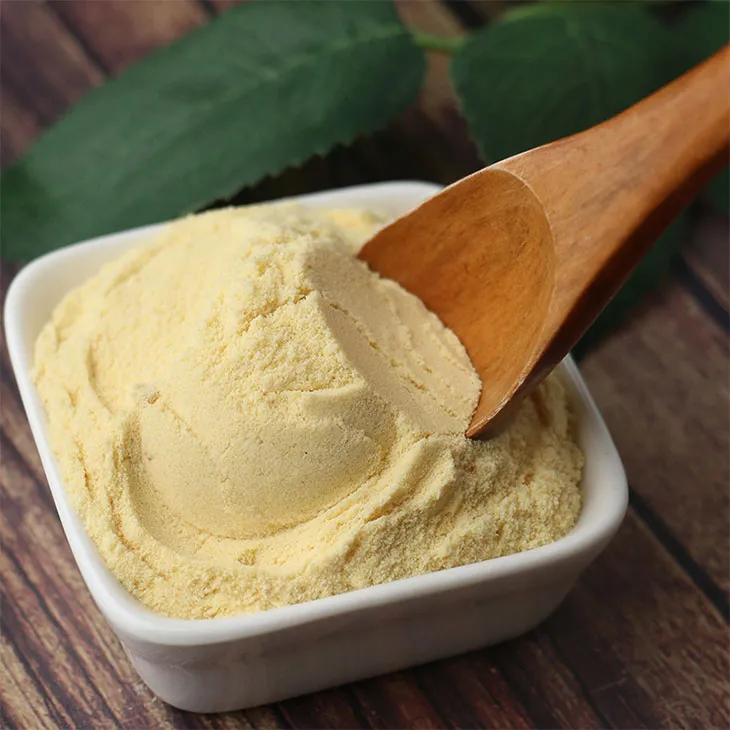- 0086-571-85302990
- sales@greenskybio.com
Active components in American ginseng root extract.
2024-11-30

Introduction
American ginseng, scientifically known as Panax quinquefolius, has been highly regarded in traditional medicine for centuries. Its root extract is a rich source of various bioactive components that contribute to its wide range of health - promoting properties. This article will explore in detail the major active components found in Panax quinquefolius root extract and their associated benefits.

Ginsenosides: Antioxidant Powerhouses
Ginsenosides are among the most well - known and studied active ingredients in American Ginseng Root Extract. These are a class of steroid - like compounds that are unique to the ginseng genus.
Chemical Structure and Varieties
Ginsenosides have a complex chemical structure, typically consisting of a triterpene aglycone (known as a sapogenin) attached to one or more sugar molecules. There are multiple types of ginsenosides, such as Rb1, Rg1, and Re, each with slightly different chemical properties. For example, Rb1 has been shown to have a different mode of action compared to Rg1 in various biological processes.
Antioxidant Mechanisms
One of the most significant properties of ginsenosides is their antioxidant effect. In the human body, normal metabolic processes generate free radicals, which are highly reactive molecules that can cause oxidative damage to cells, proteins, and DNA. Ginsenosides act as antioxidants by several mechanisms:
- Free Radical Scavenging: Ginsenosides can directly interact with free radicals, such as superoxide anions and hydroxyl radicals, and neutralize them. This prevents the free radicals from reacting with and damaging cellular components.
- Enzyme Modulation: They can also influence antioxidant enzymes in the body. For instance, ginsenosides may increase the activity of superoxide dismutase (SOD), an enzyme that catalyzes the conversion of superoxide anions to less harmful molecules like hydrogen peroxide. Additionally, they may enhance the activity of glutathione peroxidase, which further detoxifies hydrogen peroxide.
Health Implications of Antioxidant Activity
The antioxidant activity of ginsenosides has several important health implications:
- Anti - Aging: By reducing oxidative damage, ginsenosides may help slow down the aging process. Oxidative stress is closely associated with the aging of cells and tissues, and the antioxidant effects of ginsenosides can counteract this process, potentially maintaining the integrity and function of cells for a longer period.
- Disease Prevention: Chronic oxidative stress is a contributing factor in many diseases, including cardiovascular diseases, neurodegenerative disorders, and certain cancers. The antioxidant properties of ginsenosides may play a role in reducing the risk of these diseases by protecting cells from damage and maintaining normal cellular function.

Polysaccharides: Boosting the Immune System
Polysaccharides are another important class of active components in American Ginseng Root Extract. These are complex carbohydrates composed of long chains of monosaccharide units.
Structure and Types
The polysaccharides in American ginseng can vary in their monosaccharide composition, linkage types, and molecular weights. Some common monosaccharides found in these polysaccharides include glucose, galactose, and mannose. Different types of polysaccharides may have different biological activities based on their unique structural features.
Immune - Enhancing Mechanisms
Polysaccharides play a crucial role in enhancing the immune function through multiple mechanisms:
- Activation of Immune Cells: They can stimulate various immune cells, such as macrophages, lymphocytes, and dendritic cells. For example, polysaccharides can enhance the phagocytic activity of macrophages, which are the first line of defense against pathogens. Macrophages engulf and destroy foreign invaders, and the activation by polysaccharides can make them more efficient in this process.
- Regulation of Cytokine Production: Polysaccharides can also regulate the production of cytokines, which are small proteins that play important roles in cell - to - cell communication in the immune system. By modulating cytokine production, polysaccharides can influence the immune response, either enhancing or suppressing it depending on the needs of the body. For instance, they may increase the production of interferon - gamma, which is involved in antiviral and anti - tumor immunity.
Immune - Related Health Benefits
The immune - enhancing properties of polysaccharides have significant health benefits:
- Defense Against Infections: A strong immune system is essential for protecting the body against various infections, including bacterial, viral, and fungal infections. By enhancing immune function, the polysaccharides in American Ginseng Root Extract can help the body better defend itself against these pathogens.
- Support for Cancer Patients: In cancer patients, the immune system is often weakened due to the disease itself and the side effects of treatments such as chemotherapy and radiotherapy. The immune - enhancing effects of polysaccharides may help boost the immune system in these patients, potentially improving their quality of life and helping them better tolerate cancer treatments.

Phenolic Compounds: Anti - Inflammatory Agents
Phenolic compounds present in American Ginseng Root Extract contribute to its anti - inflammatory capabilities. These compounds are characterized by the presence of one or more phenolic rings in their chemical structure.
Types and Sources
There are various types of phenolic compounds in American ginseng, including flavonoids, phenolic acids, and lignans. These compounds can be synthesized by the plant during its growth and development. For example, flavonoids are often found in the leaves and roots of American ginseng and are known for their diverse biological activities.
Anti - Inflammatory Mechanisms
The anti - inflammatory effects of phenolic compounds are mediated through several mechanisms:
- Inhibition of Inflammatory Enzymes: Phenolic compounds can inhibit enzymes such as cyclooxygenase (COX) and lipoxygenase (LOX), which are involved in the production of inflammatory mediators. For example, COX enzymes catalyze the conversion of arachidonic acid to prostaglandins, some of which are pro - inflammatory. By inhibiting COX enzymes, phenolic compounds can reduce the production of these pro - inflammatory prostaglandins.
- Modulation of Inflammatory Signaling Pathways: They can also interfere with inflammatory signaling pathways in cells. For instance, phenolic compounds may regulate the nuclear factor - kappa B (NF - κB) pathway, which is a key regulator of inflammation. By modulating this pathway, they can prevent the activation of genes involved in inflammation, thereby reducing the inflammatory response.
Benefits in Inflammatory Conditions
The anti - inflammatory properties of phenolic compounds in American Ginseng Root Extract can potentially alleviate various inflammatory conditions:
- Arthritis: Inflammatory arthritis, such as rheumatoid arthritis, is characterized by chronic inflammation in the joints. The anti - inflammatory effects of phenolic compounds may help reduce joint pain, swelling, and stiffness associated with this condition.
- Cardiovascular Inflammation: Inflammation in the cardiovascular system is a risk factor for the development of heart diseases. Phenolic compounds may help reduce this inflammation, potentially improving cardiovascular health by decreasing the risk of atherosclerosis, thrombosis, and other cardiovascular disorders.

Other Minor Components and Their Potential Roles
In addition to ginsenosides, polysaccharides, and phenolic compounds, American Ginseng Root Extract also contains other minor components that may contribute to its overall health - promoting properties.
Volatile Oils
Volatile oils are present in small amounts in American ginseng root. These oils are composed of a variety of volatile organic compounds, such as terpenes and sesquiterpenes. Although their exact functions are not fully understood, they may contribute to the characteristic aroma of American ginseng and potentially have some biological activities, such as antimicrobial or antioxidant effects.
Amino Acids
American ginseng root contains a range of amino acids, which are the building blocks of proteins. Some amino acids, such as arginine and glutamine, may play important roles in physiological processes. For example, arginine is involved in the synthesis of nitric oxide, which has vasodilatory effects and may be beneficial for cardiovascular health.
Minerals
Minerals such as potassium, calcium, and magnesium are also present in American ginseng root. These minerals are essential for various physiological functions, including nerve conduction, muscle contraction, and bone health. While the contribution of these minerals from American ginseng root extract to overall mineral intake may be relatively small, they can still be part of a balanced diet.
Conclusion
American ginseng root extract is a rich source of active components, each with its own unique properties and potential health benefits. Ginsenosides, polysaccharides, and phenolic compounds are the major active ingredients, with antioxidant, immune - enhancing, and anti - inflammatory effects, respectively. Additionally, other minor components such as volatile oils, amino acids, and minerals may also contribute to the overall health - promoting properties of the extract. Further research is needed to fully understand the mechanisms of action of these components and their potential applications in promoting human health.
FAQ:
What are the main active components in American ginseng root extract?
The main active components in American ginseng root extract are ginsenosides, polysaccharides, and phenolic compounds.
How do ginsenosides in American ginseng root extract benefit health?
Ginsenosides in American ginseng root extract are known for their antioxidant effects. They can combat free radicals in the body, which is beneficial for overall health.
What is the role of polysaccharides in American ginseng root extract?
Polysaccharides in American ginseng root extract play a crucial role in enhancing immune function, which helps the body defend against diseases.
How do phenolic compounds in American ginseng root extract contribute to health?
Phenolic compounds in American ginseng root extract contribute to its anti - inflammatory capabilities, potentially alleviating various inflammatory conditions.
Can American ginseng root extract help improve the immune system?
Yes, American ginseng root extract can help improve the immune system. The polysaccharides in it play a crucial role in enhancing immune function.
Related literature
- Active Components and Pharmacological Activities of American Ginseng."
- "The Bioactive Compounds of Panax quinquefolius: A Review."
- "Health - Promoting Properties of American Ginseng Root Extract: Role of Active Components."
- ▶ Hesperidin
- ▶ citrus bioflavonoids
- ▶ plant extract
- ▶ lycopene
- ▶ Diosmin
- ▶ Grape seed extract
- ▶ Sea buckthorn Juice Powder
- ▶ Beetroot powder
- ▶ Hops Extract
- ▶ Artichoke Extract
- ▶ Reishi mushroom extract
- ▶ Astaxanthin
- ▶ Green Tea Extract
- ▶ Curcumin Extract
- ▶ Horse Chestnut Extract
- ▶ Other Problems
- ▶ Boswellia Serrata Extract
- ▶ Resveratrol Extract
- ▶ Marigold Extract
- ▶ Grape Leaf Extract
- ▶ blog3
- ▶ blog4
-
The Most Highly - Praised Lavender Extract.
2024-11-30
-
Organic Goldenseal Extract Powder Suppliers.
2024-11-30
-
Standard - process pine bark extract powder.
2024-11-30
-
Nature's Bounty Almond Powder
2024-11-30
-
Organic Taurine Powder Suppliers.
2024-11-30
-
Bulk purchase of black pepper extract.
2024-11-30
-
Chaste Berry Extract
2024-11-30
-
Oyster Mushroom Extract Powder
2024-11-30
-
Gynostemma pentaphyllum extract
2024-11-30
-
Bayberry Extract
2024-11-30
-
Beetroot juice Powder
2024-11-30
-
Citrus Aurantium Extract
2024-11-30
-
Aminolevulinic acid
2024-11-30
-
Hericium erinaceus extract powder
2024-11-30
-
Phellodendron Extract
2024-11-30
-
Wheat Germ Extract
2024-11-30





















